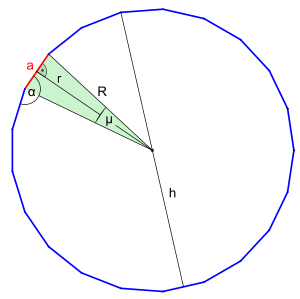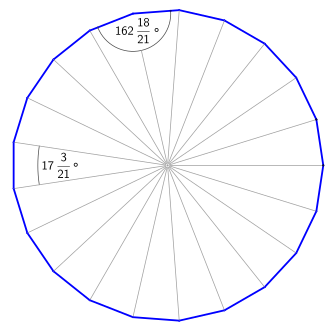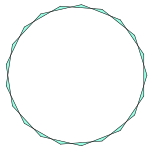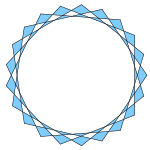A twenty-one , also 21- sided or icosihenagon , is a polygon with 21 sides and 21 corners.
Regular 21-gon
According to Carl Friedrich Gauß and Pierre-Laurent Wantzel, the regular 21-gon, in which all sides are the same length and all corner points are conceptually on a common circumference , is not a constructible polygon , so that a regular 21- gon cannot be constructed with compasses and ruler alone is.
Diagonals
Generally applies to the number of diagonals in a corner



thus the 21-gon has 189 diagonals. For each of the 21 corners at which a diagonal can begin, there are 18 possible end points. This number has to be divided by 2 so that no diagonal is counted twice.
This is how the mentioned diagonals result.

Sizes
| Sizes of a regular 21-gon
|
|
Interior angle
|

|

|
|
Central angle
(Center angle)
|

|
|
Side length
|

|
|
Perimeter radius
|

|
|
Inscribed radius
|

|
|
height
|

|
|
Area
|

|
Mathematical relationships
Interior angle
The interior angle is enclosed by two adjacent sides of the length .



Central angle
The central angle or center angle is enclosed by two adjacent circumferential radii of the length .



Side length
The side length is calculated as follows

-
 .
.
Perimeter radius
The radius of the perimeter results from transforming the formula for the side length to


-
 .
.
Inscribed radius
The incircle radius is the height of an isosceles partial triangle with the two legs equal to the circumferential radius and the base line equal to the side length :




height
The height of a regular 21-corner results from the sum of the inscribed radius and the circumferential radius



Area
The area of a triangle is generally calculated as . The results of the side length and the incircle radius are used to calculate the 21-gon , where the following is used for the height :






-
 from this follows for the area of a partial triangle
from this follows for the area of a partial triangle
-
 summarized it results
summarized it results
-
 and for the area of the entire 21-gon
and for the area of the entire 21-gon

Geometric constructions
As explained in the paragraph of the same name, a regular 21-sided cannot be constructed with a compass and ruler . However, if you use an additional tool such as B. the tomahawk for the exact trisection of an angle or a special curve ruler with the curve shape of the Archimedean spiral or the quadratrix of Hippias for the division of the 90-degree angle into equal angles , an exact solution is feasible .

In order to be able to use the tomahawk to determine the central angle , a possibly complicated construction of at least a suitable angle width is required, as can be seen in the example of Heptagon by Andrew M. Gleason .
In contrast, both the Archimedean spiral and the quadratrix of Hippias offer a simple and short path - it leads by dividing a line into parts of equal length and then projecting four of these parts into the selected curve - to find the central angle sought.

With a given radius
The construction of the 21-sided polygon with a given radius (Figure 1) uses as a constructional element, as well as in Dreizehneck can be seen, the quadratrix of hippias as an additional device.
After drawing the square z. B. with the side length and the construction of the special curve, the so-called quadratic rix of Hippias , with the parametric representation :



the route is divided into twenty-one equal sections using the route division. For the sake of clarity, only the relevant points are shown in the drawing.

The central angle of the 21-gon arises from this, but the quadrix of Hippias only divides the angles down to equal angles. It follows that a twenty-first of the distance can only achieve a twenty-first of the angle . Therefore, because of the calculation of the central angle from the circumference with its four times a twenty-first, i.e. H. the dividing point of the line used to construct the central angle . This arises after the construction of a parallel to from to the curve of the quadratrix, which results in the point . Now you draw a half line from the angle point through to the perimeter.















This results in the central angle and the second corner point on the circumference . The length of the line is the exact length of the side of the regular 21-gon with a given circumference.





Fig. 1: Regular 21-gon with a given circumference as an exact construction with the quadrix of Hippias as an additional aid
With a given side length
The construction of the 21-gon with a given side length as shown in (Fig. 2) is, as it were, the continuation of the construction of the 21-gon with a given circumference (Fig. 1). It also uses the Hippias Quadratrix as a construction element as an additional aid. The given side length is, depending on the point of view, incorporated as a central extension of the perimeter of the 21-gon with a so-called negative extension factor or as a geometric similarity between two triangles.


Taking into account that the points and in Fig. 2 correspond to the points and in Fig. 1, the construction description of the 21 ‐ gon can be completely adopted for a given circumference .




All that is required is a bisector of the central angle on a circle with the diameter equal to the given side length by point and finally two parallels, one each from and to the angle legs of the central angle.








The resulting intersection points and are the first two corner points and the route is the exact circumferential radius of the 21-gon with the specified side length.



Regular 21 overturned corner
A regular overturned 21-gon is obtained if at least one is skipped over each time when connecting the twenty-one corner points and the tendons thus created are of the same length. Such regular stars are noted with Schläfli symbols , indicating the number of corner points and connecting every -th point.



There are only five regular twenty-one ray stars.
The "stars" with the symbols {21/3} and {21/18} are regular heptagons, {21/6} and {21/15} as well as {21/9} and {21/12} are regular heptagrams , { 21/7} and {21/14} are equilateral triangles .
- Regular twenty-one ray stars





Web links
Individual evidence
-
^ Rieke Deimer: The Quadratrix. In: Mathematics / Algebraic Geometry, Selected Higher Curves WS2016-17. University of Mainz, January 6, 2017, accessed on September 8, 2018 .
-
↑ Hans-Wolfgang Henn: Elementary Geometry and Algebra. Vieweg + Teubner Verlag, 2003, pp. 45-48. Page 46 ff. Quadratrix ( excerpt (Google) ), accessed on September 8, 2018.
-
↑ Horst Hischer: Mathematik in der Schule 32 (1994) 5. History of mathematics as a didactic aspect (2). Solution of classic problems. P. 279 ff. , Accessed on September 8, 2018 .
-
↑ Friedhelm Kürpig Oliver Niewiadomski: Basic theory of geometry, concepts, theorems, basic constructions; Verlag Friedr. Vieweg & Sohn, 1992 page 61 centric stretching ( excerpt (Google) ), accessed on September 8, 2018.











































































